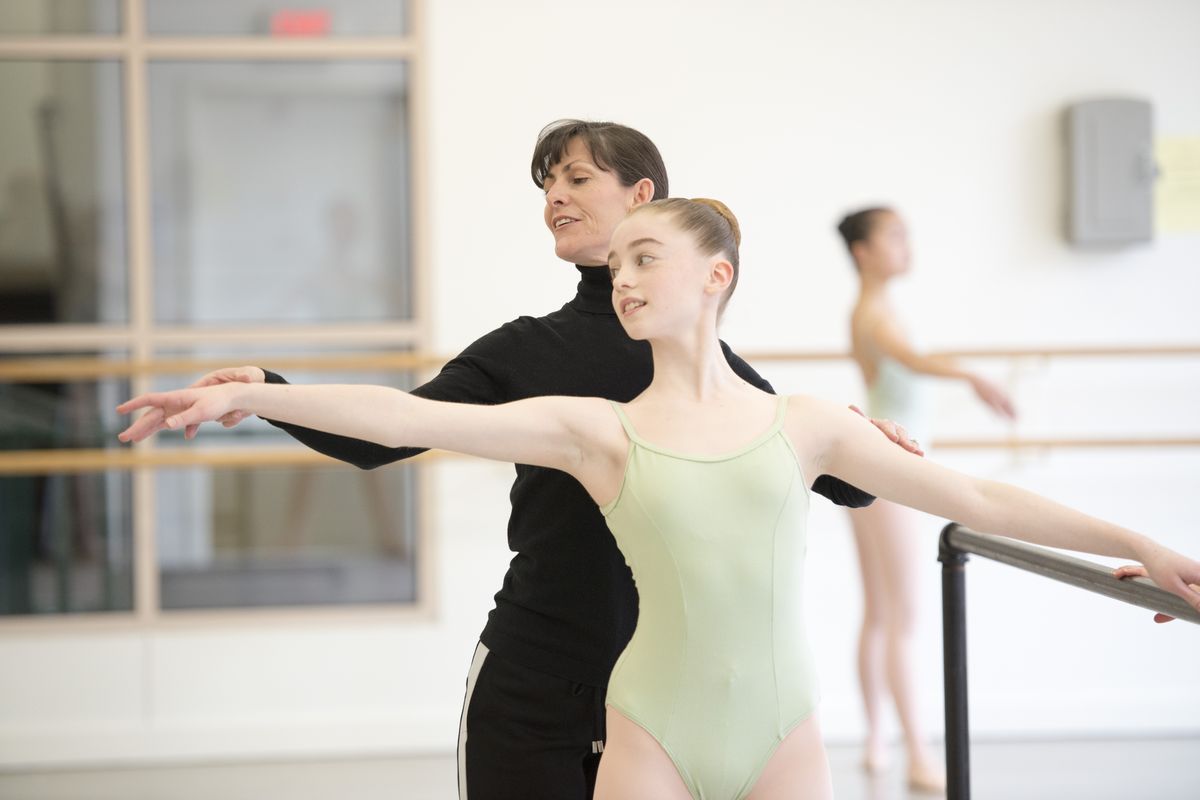
A raspy voice and sore muscles are not obligatory for teachers, but that’s often what happens after hours of teaching. Being a dance teacher is physically, mentally and emotionally demanding. Unfortunately, whether it’s because you’re pressed for time or that you’re focused solely on your students, self-care isn’t always the top priority. You might think you don’t have time to attend to your personal well-being, but what you really don’t have time for is an injury. Here are seven strategies that will help keep you injury-free and at the top of your game.
1. Find your breath
A normal day for Catey Ott Thompson, who teaches at Marquette University, Milwaukee Ballet and Danceworks, involves toggling between administration and movement. Being aware of her breath helps her connect to her body and manage stress. “When I feel pain, am clenching or feel overwhelmed,” says Ott Thompson, “I just exhale.”
Additionally, talking while dancing (as you do while teaching) challenges the respiratory system and can stress your diaphragm muscle. Because the diaphragm is attached to your spine and has an essential role in core support, stress on the diaphragm can bring a host of issues, including back pain.
Breathing exercises can improve your abdominal coordination, helping your body stay strong and healthy. Ott Thompson recommends a simple approach: During an inhale, observe habits or scan for hidden tension, then concentrate on a slow, grounding exhale.
2. Preserve your voice
Unless you’re a musical theater dancer, you probably never learned to care for your voice. Matt Pardo, who’s performed with Lucinda Childs Dance and taught at institutions like Elon University and Shenandoah University, finds that when the studio is large and full of loud music, he’s tempted to lift his chin and chest to try to push his voice out. However, years of classical voice training have taught him that it’s better to resonate his voice from a relaxed chest. As Pardo explains, “Leave the head toward the back; then the neck is in alignment, and you’re able to project more.”
He also suggests establishing short cues and prompts with students the first few weeks of every term to spare your voice. For example, if Pardo says “Toes” during rond de jambe, students know that he wants to see better articulation in the feet.
3. Take your own advice
You probably advise students to stretch, cross-train, warm up and cool down. Don’t forget to do these things yourself. Use your dancer discipline to carve out time each day to condition your body. “I absolutely religiously do a floor barre/Pilates/stretching routine every morning seven days a week. It takes about 30 minutes,” says Dierdre Miles Burger, assistant education director and head of curriculum at The Sarasota Ballet. “If I can, I add 10 minutes on the elliptical, or, more likely, take the dog for a brisk walk.” Before you pack up for the day, or hop in the car or sit down to a pile of paperwork, spend a few minutes stretching and cooling down, too.
4. Work bilaterally
You never did like your extension on the right side, and now that you’re not a student, you might think you don’t need to use it, but you’re wrong. Bilateral demonstration is important for preventing injuries because asymmetry puts imbalanced loads on the body, making you vulnerable to injury by stressing the joints and tissues. Many things in the classroom can prevent you from working both sides of the body. Perhaps the spot that makes you most visible to students means you stand facing one direction, or a lingering injury discourages you from ever standing on your left leg. Hold yourself accountable to demonstrating with the right and the left. Try switching back and forth: pliés on the right, tendus on the left.
5. Treat your feet
Your feet are the foundation of your body, and without a strong base it’s hard to build a good structure. The ballet slippers, bare feet or socks that worked for you as a dancer might not be enough now. When you age, your feet can become more irritable as cartilage thins, bone degenerates and muscle fibers are replaced with more-rigid collagen. A structured dance sneaker might better suit your needs. Tamara King, principal of Boston Ballet School’s Newton studios, finds the arch and heel support of her sneakers is essential when she’s teaching.
Your feet also provide balance feedback to your nervous system, so King recommends teachers do a 10-minute foot warm-up. Before teaching, roll your feet over a small ball. Thread your fingers through your toes, and mobilize your mid-foot with gentle twists. Practice doming your arches, and finish by pointing and flexing with an exercise band.
6. Let technology in
Emphatic demonstrations to illustrate a point to your students are tempting, but going from nothing to 200 percent is exhausting and puts you at risk for injury. Even more hazardous is imitating students’ errors; there’s a reason you don’t want their knees rolling in on a landing from a jump. This might sound like sacrilege, but let technology help you. Using the video function on a phone can show students what you’re seeing. Video is a vivid, objective medium that can help students learn how to self-evaluate. Let their devices be helpful practice tools, not just distractions.
7. Stay present
Most important, stay present. Do you ever find yourself thinking about your students, business and class structure all at once? This divided focus can prevent you from catching your body’s warning signals and puts you at risk for injury. Somatic techniques or meditation can help you learn to reduce mental clutter. For example, Alexander Technique (a somatic technique designed to improve postural efficiency) helped Adele Nickel to be mindful of her own experience while teaching dance: “Every time I step into the studio, I aim to quiet down inside myself and cultivate a listening attitude.” Nickel feels that connecting to herself and the present moment improves her teaching by helping her see her students and relay her intentions more clearly. “If you’re stressed-out and nervous, then that’s what you’re communicating, no matter what you’re saying with your words.”




